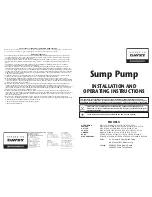
15-600 Page 7
SECTION 2
INSTALLATION & OPERATING INSTRUCTIONS
FOR GARDNER DENVER PZ SERIES & PXL SINGLE ACTING POWER PUMPS
Reference to Parts List covering the Model Pump being serviced is recommended in connection with this
Instruction Manual.
Repair Parts Lists with Sectional Views are available from any Gardner Denver Sales and Service
Office. When ordering parts, always give size and serial number of pump. Always use genuine Gardner
Denver parts. For efficient, factory-trained service, consult a Gardner Denver Service Specialist.
START-UP –
Pumps are shipped from the factory
without oil in the crankcase. The hood should be
removed and the power end examined and cleaned if
necessary. The pump may have been in storage or in
the yard for sometime and as a consequence dirt may
have entered the crankcase. Parts may have been
robbed from the pump during storage and not
replaced. All nuts and screws should be tightened.
Be sure all valves in the discharge line are open. No
valve should be installed between the pump and
pressure relief valve in discharge line.
To prevent excessive wear on the fluid pistons and
packing when starting, remove a suction valve cover
plate on each side of the fluid end and prime the pump.
Pump should be started slowly, if possible, and should
be operated for several hours with practically no
discharge pressure. Check oil level as it may be
necessary to add a small quantity of oil to compensate
for that adhering to the walls of the crankcase the
moving parts. The pump may then gradually be
brought up to full speed and full working pressure.
Watch for undue heating or abnormal noise in the
working parts. Check all joints in the suction line to be
sure there are no air leaks.
DANGER
When working on any pump, be certain
there is no fluid pressure on either the
suction or discharge side. Pressure on
the fluid end might move the pump and
cause damage or injury to personnel. It
is recommended that all suction valve
covers be removed to avoid fluid
pressure building up against the pistons
or plungers.
DANGER
If the drive is not to be removed, it is
recommended that the air line to the
clutch be disconnected to prevent
accidental starting of the pump.
LOCATION
- Pump should be set level and solidly
supported. The drive should be accurately aligned.
Pump should be placed as close to the slush pit as
possible to keep the suction line short and direct.
Locate pump as low as possible to maintain a
minimum suction lift to the centrifugal charging pump
which is used because of the high speed of this type of
mud pump.
When the pump skid or master skid is to be bolted or
welded to a platform or deck in the field, it is necessary
that the following “Final Shimming Procedure” be
followed.
Final Shimming Procedure
- After the pump skid or
master skid has been bolted or welded to a stationary
platform or deck, proceed as follows:
a.
Remove the cap screws used to secure the pump
frame to its skid.
b.
At each foot where a space exists between foot
and skid, place a dial indicator on the frame foot
and skid as shown in FIGURE 1. Set dial to
ZERO.
c.
Place shims between frame foot and skid where
space exists so the dial indicator shows the frame
has been raised approximately .005 to .010
inches (.126 to .254 mm).
d.
Securely tighten the frame to skid cap screws. If
the proper number of shims were used, the dial
indicator should return to /-.003 inches
(.076 mm) of zero. If not, repeat the procedure
changing number of shims used.













































